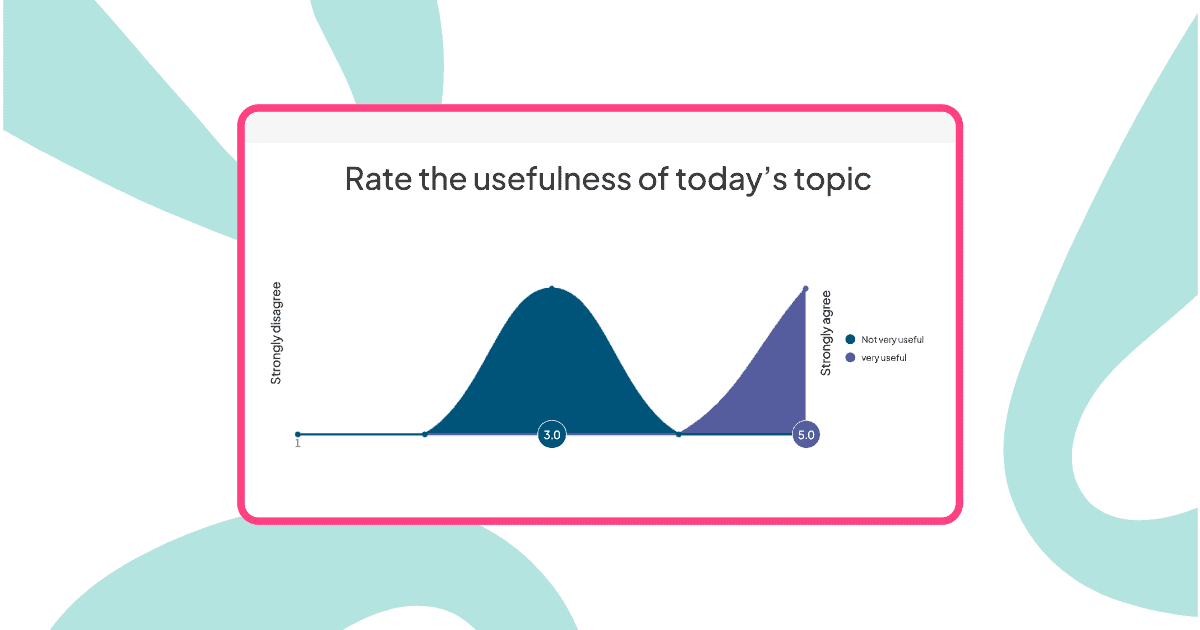Vi site mai dumandatu cumu si sentenu veramente i vostri impiegati nantu à i so roli, cuntribuzioni è a satisfaczione generale di u travagliu?
Una carriera appagante ùn hè più limitata à un salariu à a fine di u mese. In l'era di u travagliu à distanza, di l'ore flessibili è di i roli di travagliu in evoluzione, a definizione di satisfaczione di u travagliu hè cambiata dramaticamente.
Eccu u prublema: l'inchieste annuali tradiziunali spessu producenu tassi di risposta bassi, insights ritardati è risposte sanificate. L'impiegati li cumpletanu soli à i so scrivanie, disconnessi da u mumentu è temendu d'esse identificati. Quandu si analizanu i risultati, i prublemi sò stati aggravati o dimenticati.
Ci hè un modu megliu. I sondaggi interattivi di suddisfazione di u travagliu realizati durante e riunioni di squadra, i cunsiglii publichi o e sessioni di furmazione catturanu feedback autentichi in u mumentu - quandu l'impegnu hè u più altu è pudete affruntà e preoccupazioni in tempu reale.
In questa guida, furniremu 46 esempi di dumande per u vostru quistionariu di satisfaczione di u travagliu, vi mostranu cumu trasfurmà i sondaggi statichi in conversazioni interessanti, è vi aiutanu à prumove una cultura di u locu di travagliu chì nutrisce l'impegnu di i dipendenti, stimula l'innuvazione è prepara u terrenu per un successu durevule.
Table di cuntinutu
- Chì ghjè un Questionariu di Soddisfazione di u Travagliu?
- Perchè fà un Questionariu di Soddisfazione di u Travagliu?
- A Differenza trà Sondaggi Tradiziunali è Interattivi
- 46 Esempi di dumande per un quistionariu di suddisfazione di u travagliu
- Cumu realizà una inchiesta efficace di suddisfazione di u travagliu cù AhaSlides
- Perchè i Sondaggi Interattivi Funzionanu Meglio Chè i Formulari Tradiziunali
- Chiave Takeaways
Chì ghjè un Questionariu di Soddisfazione di u Travagliu?
Un quistionariu di satisfaczione di u travagliu, cunnisciutu ancu cum'è inchiesta di satisfaczione di l'impiegati, hè un strumentu strategicu utilizatu da i prufessiunali di e risorse umane è i dirigenti urganizativi per capisce quantu i so impiegati sò soddisfatti in i so roli.
Si compone di dumande attentamente elaborate per copre aree critiche cumprese l'ambiente di travagliu, e responsabilità di u travagliu, e relazioni cù i culleghi è i supervisori, a compensazione, l'opportunità di crescita, u benessere è assai di più.
L'approcciu tradiziunale: Mandate un ligame di sondaggio, aspettate chì e risposte ghjunghjenu à pocu à pocu, analizate i dati settimane dopu, poi implementate cambiamenti chì parenu disconnessi da e preoccupazioni uriginali.
L'approcciu interattivu: Prisentate dumande in diretta durante e riunioni, raccogliete feedback immediati per mezu di sondaggi anonimi è nuvole di parole, discutete i risultati in tempu reale è sviluppate in cullaburazione suluzioni mentre a cunversazione hè fresca.
Perchè fà un Questionariu di Soddisfazione di u Travagliu?
A ricerca di Pew mette in risaltu chì guasi u 39% di i travagliadori micca indipendenti consideranu u so travagliu cruciale per a so identità generale. Stu sentimentu hè furmatu da fattori cum'è u redditu familiale è l'educazione, cù u 47% di e persone cù redditi più alti è u 53% di i post-laureati chì attribuiscenu impurtanza à a so identità prufessiunale. Questa interazione hè cruciale per a satisfaczione di l'impiegati, rendendu un quistionariu di satisfaczione prufessiunale ben strutturatu essenziale per nutrisce u scopu è u benessere.
A realizazione di un quistionariu di satisfaczione di u travagliu offre vantaghji sustanziali sia per i salariati sia per l'urganizazione:
Comprensione Perspicace
Dumande specifiche rivelanu i veri sentimenti di l'impiegati, svelendu opinioni, preoccupazioni è aree di soddisfazione. Quandu sò realizate in modu interattivu cù opzioni di risposta anonime, si evita a paura di l'identificazione chì spessu porta à feedback disonesti in i sondaggi tradiziunali.
Identificazione di u prublema
E dumande mirate identificanu i punti di dulore chì affettanu u morale è l'impegnu, ch'elli sianu ligati à a cumunicazione, à a carica di travagliu o à l'opportunità di crescita. E nuvole di parolle in tempu reale ponu visualizà istantaneamente induve a maiò parte di l'impiegati anu difficultà.
Soluzioni su misura
L'infurmazioni raccolte permettenu suluzioni persunalizate, dimustrendu u vostru impegnu à migliurà e cundizioni di travagliu. Quandu l'impiegati vedenu u so feedback affissatu immediatamente è discussu apertamente, si sentenu veramente ascoltati piuttostu chè solu interrugati.
Impegnu è Ritenzione Migliorati
Affruntà e preoccupazioni basate nantu à i risultati di u quistionariu aumenta l'ingaghjamentu, cuntribuendu à un riduzzione di u turnover è à una maggiore fideltà. I sondaggi interattivi trasformanu a raccolta di feedback da un eserciziu burocraticu in una conversazione significativa.
A Differenza trà Sondaggi Tradiziunali è Interattivi
| aspettu | Sondaggio tradiziunale | Sondaggio interattivu (AhaSlides) |
|---|---|---|
| Timing | Mandatu per email, cumpletatu solu | Cunduttu in diretta durante e riunioni |
| Risposta manghjata | 30-40% media | 85-95% quandu hè presentatu in diretta |
| Anonimatu | Dubbiosu - l'impiegati sò preoccupati per u seguimentu | Veru anonimatu senza bisognu di login |
| Impegnu | Si sente cum'è i compiti | Si sente cum'è una cunversazione |
| Risposte alla lingua | Ghjorni o settimane dopu | Visualizazione istantanea è in tempu reale |
| Action | Ritardatu, scollegatu | Discussione è suluzioni immediate |
| furmatu | Forme statiche | Sondaggi dinamici, nuvole di parolle, dumande è risposte, valutazioni |
L'intuizione chjave: A ghjente s'impegna di più quandu u feedback si sente cum'è un dialogu piuttostu chè una documentazione.
46 Esempi di dumande per un quistionariu di suddisfazione di u travagliu
Eccu alcuni esempi di dumande urganizate per categuria. Ogni sezione include indicazioni nantu à cumu presentalli in modu interattivu per una massima onestà è impegnu.
Ambiente di travagliu
Questions:
- Cumu valutate u cunfortu fisicu è a sicurità di u vostru spaziu di travagliu?
- Sì suddisfattu di a pulizia è di l'urganizazione di u locu di travagliu ?
- Sentite chì l'atmosfera di l'uffiziu prumove una cultura di u travagliu pusitivu?
- Avete furnitu i strumenti è e risorse necessarii per fà u vostru travagliu in modu efficace?
Approcciu interattivu cù AhaSlides:
- Aduprate scale di valutazione (1-5 stelle) visualizate in diretta
- Segui cù una nuvola di parolle aperta: "In una parolla, descrivite l'atmosfera di u nostru locu di travagliu"
- Attivà a modalità anonima per chì l'impiegati valutinu onestamente e cundizioni fisiche senza paura
- Mostra subitu i risultati aggregati per inizià a discussione
Perchè funziona: Quandu l'impiegati vedenu chì l'altri spartenu preoccupazioni simili (per esempiu, parechje persone valutanu "strumenti è risorse" cum'è 2/5), si sentenu validati è più disposti à spiegà in e sessioni di dumande è risposte di seguitu.
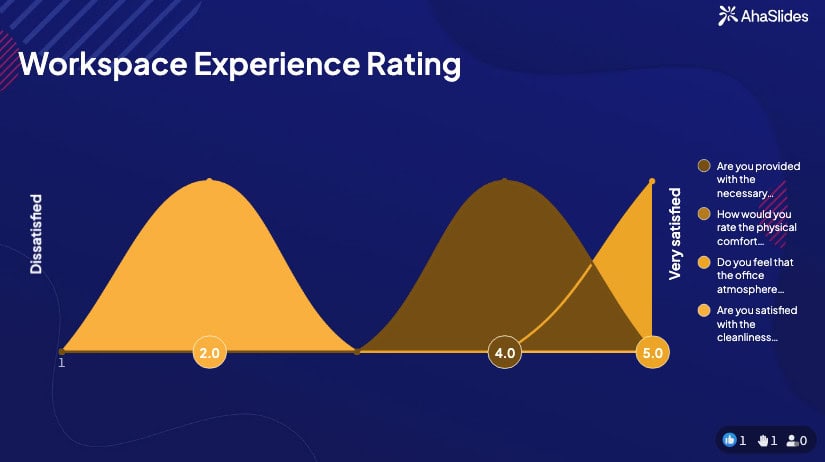
Pruvate un mudellu di sondaggio nantu à l'ambiente di travagliu →
rispunsabilità Job
Questions:
- E vostre rispunsabilità di u travagliu attuale sò in linea cù e vostre cumpetenze è qualifiche?
- Sò i vostri compiti chjaramente definiti è cumunicati à voi?
- Avete l'uppurtunità di piglià novi sfide è espansione e vostre cumpetenze?
- Sò cuntentu di a varietà è a cumplessità di e vostre attività di ogni ghjornu?
- Sentite chì u vostru travagliu vi dà un sensu di scopu è di realizazione?
- Sò cuntentu di u livellu di l'autorità di decisione chì avete in u vostru rolu?
- Credi chì e vostre rispunsabilità di travagliu sianu in cunfurmità cù l'ubbiettivi è a missione generale di l'urganizazione?
- Avete furnitu linee è aspettative chjaru per i vostri travaglii è prughjetti di travagliu?
- Quantu vi sentite chì e vostre responsabilità di u travagliu cuntribuiscenu à u successu è a crescita di a cumpagnia?
Approcciu interattivu cù AhaSlides:
- Prisentate sondaggi sì/nò per dumande di chiarezza (per esempiu, "I vostri compiti sò chjaramente definiti?")
- Aduprate scale di valutazione per i livelli di soddisfazione
- Segui cù una sessione aperta di dumande è risposte: "Chì rispunsabilità vuleresti aghjunghje o caccià?"
- Crea una nuvola di parolle: "Descrivite u vostru rolu in trè parolle"
punta Pro: A funzione di dumande è risposte anonime hè particularmente putente quì. L'impiegati ponu mandà dumande cum'è "Perchè ùn avemu micca più autonomia in a presa di decisioni?" senza paura d'esse identificati, ciò chì permette à i dirigenti di trattà apertamente i prublemi sistemichi.
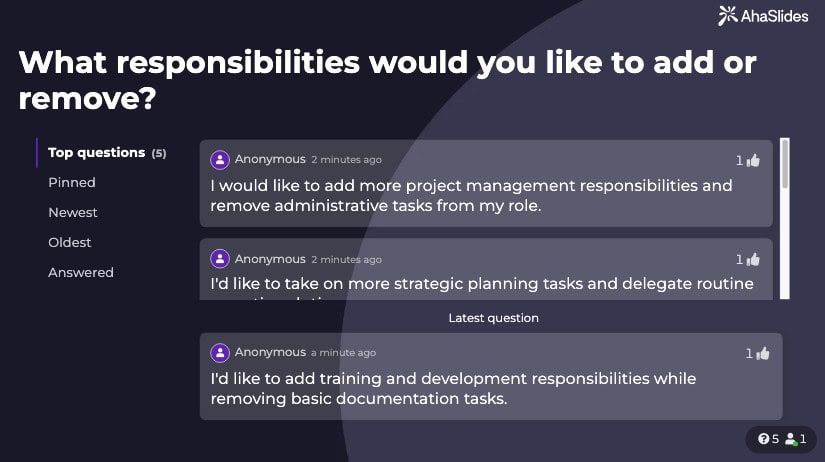
Supervisione è Leadership
Questions:
- Cumu valutate a qualità di a cumunicazione trà voi è u vostru supervisore?
- Ricevete un feedback constructivu è una guida nantu à a vostra prestazione?
- Sò incuraghjitu à esprime e vostre opinioni è suggerimenti à u vostru supervisore?
- Pensate chì u vostru supervisore apprezza i vostri cuntributi è ricunnosce i vostri sforzi?
- Sò cuntentu di u stilu di dirigenza è l'approcciu di gestione in u vostru dipartimentu?
- Quali tipi di cumpetenze di leadership pensate chì saranu e più efficaci in a vostra squadra?
Approcciu interattivu cù AhaSlides:
- Aduprate scale di valutazione anonime per feedback sensibili di i supervisori
- Presentà l'opzioni di stile di leadership (demucraticu, coaching, trasfurmazionale, ecc.) è dumandà quali impiegati preferiscenu
- Attivà Q&A in diretta induve l'impiegati ponu fà dumande nantu à l'approcciu di gestione
- Creà classifiche: "Chì hè ciò chì conta di più per voi in un supervisore?" (Cumunicazione, Riconoscimentu, Feedback, Autonomia, Supportu)
Perchè l'anonimatu hè impurtante: Sicondu a vostra scheda di pusizionamentu, i prufessiunali di e risorse umane anu bisognu di "creà spazii sicuri per una discussione onesta". I sondaggi anonimi interattivi durante e riunioni publiche permettenu à l'impiegati di valutà a leadership onestamente senza preoccupazioni di carriera - qualcosa chì i sondaggi tradiziunali anu difficultà à ottene in modu cunvincente.
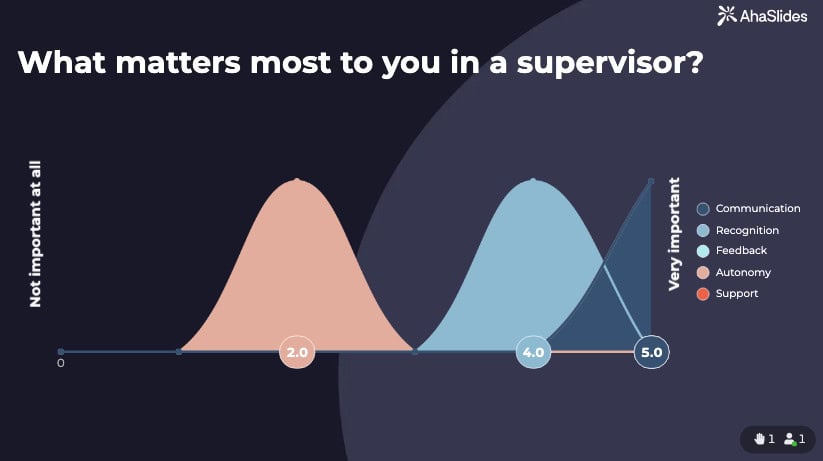
Sviluppu è crescita di carriera
Questions:
- Avete furnitu opportunità per a crescita è l'avanzamentu prufessiunale?
- Quantu site suddisfattu di i prugrammi di furmazione è di sviluppu offerti da l'urganizazione?
- Crede chì u vostru rolu attuale hè in linea cù i vostri scopi di carriera à longu andà?
- Vi sò datu l'uppurtunità di piglià roli di dirigenza o prughjetti spiciali?
- Avete ricevutu supportu per perseguite una educazione ulteriore o un rinfurzà di e cumpetenze?
Approcciu interattivu cù AhaSlides:
- Sondaggio: "Chì tipu di sviluppu prufessiunale vi beneficerebbe di più?" (Formazione di leadership, cumpetenze tecniche, certificazioni, mentoring, movimenti laterali)
- Nuvola di parolle: "Induve ti vedi in 3 anni?"
- Scala di valutazione: "Quantu ti senti sustinutu in u vostru sviluppu di carriera?" (1-10)
- Dumande è risposte aperte per chì l'impiegati possinu dumandà infurmazioni nantu à opportunità di sviluppu specifiche
Vantaghju strategicu: À u cuntrariu di l'inchieste tradiziunali induve sti dati si trovanu in un fogliu di calculu, a presentazione di dumande di sviluppu di carriera in diretta durante e revisioni trimestrali permette à e Risorse Umane di discute immediatamente i budget di furmazione, i prugrammi di mentoring è l'opportunità di mobilità interna mentre a cunversazione hè attiva.
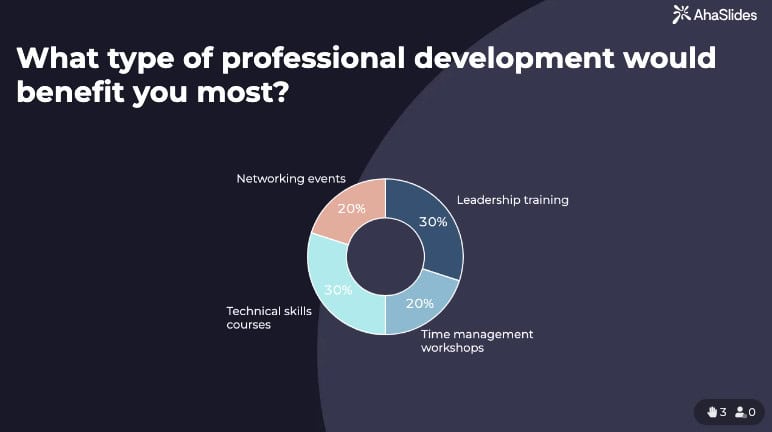
Indennità è Benefiti
Questions:
- Sò cuntentu di u vostru salariu attuale è di u pacchettu di compensazione, cumprese i benefici marginali?
- Sentite chì i vostri cuntributi è rializazioni sò ricumpinsati in modu adattatu?
- I benefici offerti da l'urganizazione sò cumpleti è adatti à i vostri bisogni?
- Cumu valutate a trasparenza è l'equità di u prucessu di valutazione di rendiment è compensazione?
- Sò cuntentu di l'opportunità per bonus, incentivi, o ricumpensa?
- Sì cuntentu di a pulitica di vacanze annuali?
Approcciu interattivu cù AhaSlides:
- Sondaggi anonimi sì/nò per dumande sensibili nantu à i salarii
- Scelta multipla: "Quali benefici sò i più impurtanti per voi?" (Assistenza sanitaria, Flessibilità, Budget di apprendimentu, Prugrammi di benessere, Ritirata)
- Scala di valutazione: "Quantu hè ghjusta a nostra compensazione in relazione à u vostru cuntributu?"
- Nuvola di parolle: "Chì benefiziu migliurerebbe di più a vostra suddisfazione?"
Nota critica: Eccu induve i sondaggi interattivi anonimi brillanu veramente. L'impiegati raramente danu feedback onestu nantu à a compensazione in i sondaggi tradiziunali chì richiedenu credenziali di login. I sondaggi anonimi in diretta durante i cunsiglii publichi, induve e risposte appariscenu senza nomi, creanu una sicurezza psicologica per un feedback genuinu.
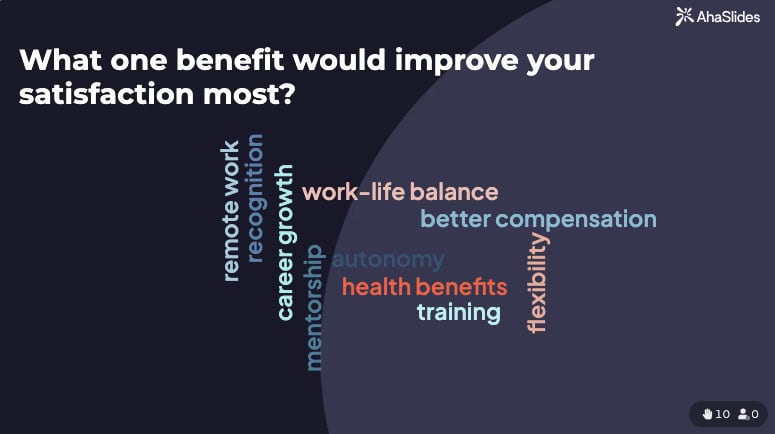
Crea a vostra sessione di feedback di compensazione →
Relazioni è Collaborazione
Questions:
- Quantu bè cullaburate è cumunicà cù i vostri culleghi?
- Sentite un sensu di camaraderia è di travagliu in squadra in u vostru dipartimentu?
- Sì suddisfattu di u livellu di rispettu è di cuuperazione trà i vostri pari ?
- Avete l'uppurtunità di interagisce cù i culleghi di diversi dipartimenti o squadre?
- Vi piace à circà aiutu o cunsiglii da i vostri culleghi quandu avete bisognu?
Approcciu interattivu cù AhaSlides:
- Scale di valutazione per a qualità di a cullaburazione
- Nuvola di parolle: "Descrivite a cultura di a nostra squadra in una sola parola"
- Scelta multipla: "Quantu spessu collaborate trà i dipartimenti?" (Quotidianamente, Settimanale, Mensilmente, Raramente, Mai)
- Dumande è risposte anonime per emergere prublemi interpersonali
Benessere è equilibriu trà vita prufessiunale è vita privata
Questions:
- Quantu site suddisfattu di l'equilibriu trà vita prufessiunale è vita privata furnitu da l'urganizazione?
- Vi sentite bè supportatu da a cumpagnia in a gestione di u stress è u mantenimentu di u vostru benessere mentale?
- Sò cunfortu à circà assistenza o risorse per gestisce e sfide persunale o di u travagliu?
- Quantu spessu participate à prugrammi o attività di benessere furnite da l'urganizazione?
- Credi chì l'impresa valorizeghja è dà priorità à u benessere di i so impiegati ?
- Sò cuntentu di l'ambiente di travagliu fisicu in termini di cunfortu, illuminazione è ergonomia?
- Quantu bè l'urganizazione si adatta à i vostri bisogni di salute è benessere (per esempiu, orari flessibili, opzioni di travagliu à distanza)?
- Ti senti incuraghjitu à piglià pause è disconnect from work when need to recharge?
- Quante volte vi sentite sopraffatti o stressati per via di fattori ligati à u travagliu?
- Sì suddisfattu di i benefici per a salute è u benessere offerti da l'urganizazione?
Approcciu interattivu cù AhaSlides:
- Scale di frequenza: "Quantu spessu vi sentite stressatu?" (Mai, Raramente, Calchì volta, Spessu, Sempre)
- Sondaggi sì/nò nantu à u sustegnu à u benessere
- Cursore anonimu: "Valuta u vostru livellu attuale di burnout" (1-10)
- Nuvola di parolle: "Chì migliurerebbe di più u vostru benessere?"
- Dumande è risposte aperte per chì l'impiegati possinu sparte e so preoccupazioni di benessere in modu anonimu
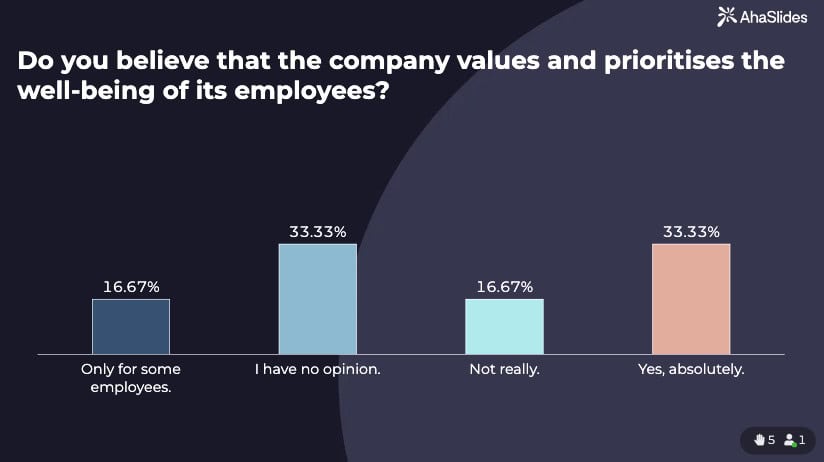
Perchè chistu importa: A vostra scheda di pusizionamentu identifica chì i prufessiunali di e risorse umane anu difficultà cù "l'impegnu è u feedback di l'impiegati" è "a creazione di spazii sicuri per una discussione onesta". E dumande di benessere sò intrinsecamente sensibili - l'impiegati temenu di parè debuli o disimpegnati s'elli ammettenu u burnout. I sondaggi anonimi interattivi eliminanu sta barriera.
Satisfazione generale
Quistioni finale: 46. Nantu à una scala da 1 à 10, quantu hè prubabile chì ricumandessi sta sucietà cum'è un bellu locu di travagliu? (Employee Net Promoter Score)
Approcciu interattivu:
- Seguitu basatu annantu à i risultati: Se i punteggi sò bassi, dumandate subitu "Chì hè l'unica cosa chì pudemu cambià per migliurà u vostru punteggio?"
- Visualizà l'eNPS in tempu reale per chì a dirigenza possi vede u sentimentu immediatu
- Aduprate i risultati per guidà una cunversazione trasparente nantu à i miglioramenti urganizativi
Cumu realizà una inchiesta efficace di suddisfazione di u travagliu cù AhaSlides
Passu 1: sceglite u vostru furmatu
Opzione A: In diretta durante e riunioni di tutti i participanti
- Presentà 8-12 dumande chjave durante e riunioni publiche trimestrali
- Aduprà a modalità anonima per i temi sensibili
- Discutite subitu i risultati cù u gruppu
- Ideale per: Custruisce a fiducia, azzione immediata, risoluzione collaborativa di prublemi
Opzione B: À u vostru ritmu ma interattivu
- Sparte un ligame di presentazione à quale l'impiegati ponu accede in ogni mumentu
- Includite tutte e 46 dumande urganizate per categuria
- Stabilite un termini per a fine
- Ideale per: Raccolta cumpleta di dati, tempi flessibili
Opzione C: Approcciu ibridu (cunsigliatu)
- Mandate 5-7 dumande critiche cum'è sondaggi à u vostru ritmu
- Presentà i risultati è e 3 principali preoccupazioni in diretta à a prossima riunione di squadra
- Aduprate e dumande è risposte in diretta per approfondire i prublemi
- Ideale per: Massima participazione cù una discussione significativa
Passu 2: Configurate u vostru sondaggio in AhaSlides
Funzioni da aduprà:
- Scale di valutazione per i livelli di soddisfazione
- Sondaggi à scelta multipla per e dumande di preferenza
- Nuvole di parolle per visualizà temi cumuni
- Dumande è risposte aperte per chì l'impiegati possinu fà dumande anonime
- Modu anonimu per assicurà a sicurezza psicologica
- Visualizzazione di risultati in diretta per mustrà trasparenza
Cunsigliu per risparmià tempu: Aduprate u generatore di IA di AhaSlides per creà rapidamente a vostra inchiesta da sta lista di dumande, dopu persunalizate per i bisogni specifichi di a vostra urganizazione.
Passu 3: Cumunicà u scopu
Prima di lancià a vostra inchiesta, spiegate:
- Perchè u fate (micca solu "perchè hè ora di sondaggi annuali")
- Cumu seranu aduprate e risposte
- Chì e risposte anonime sò veramente anonime
- Quandu è cumu spartirete i risultati è piglierete azzioni
Script di custruzzione di fiducia: "Vulemu capisce ciò chì pensate veramente di travaglià quì. Usemu sondaggi interattivi anonimi perchè sapemu chì i sondaggi tradiziunali ùn catturanu micca u vostru feedback onestu. E vostre risposte cumpariscenu senza nomi, è discuteremu i risultati inseme per sviluppà suluzioni in cullaburazione."
Passu 4: Prisentazione in diretta (s'ellu hè applicabile)
Struttura di a riunione:
- Introduzione (2 minuti): Spiegate u scopu è l'anonimatu
- Dumande di l'inchiesta (15-20 minuti): Prisentate i sondaggi unu per unu, mustrendu i risultati in diretta
- Discussione (15-20 minuti): Affrontà subitu e preoccupazioni principali
- Pianificazione di l'azione (10 minuti): Impegnatevi à i prossimi passi specifici
- Dumande è risposte di seguitu (10 minuti): Apertura di u pianu per dumande anonime
punta Pro: Quandu cumpariscenu risultati sensibili (per esempiu, u 70% valuta a cumunicazione di a dirigenza cum'è scarsa), ricunnosciteli subitu: "Questu hè un feedback impurtante. Discutemu ciò chì significa per voi "una cumunicazione scarsa". Aduprate e dumande è risposte per sparte esempi specifici in modu anonimu".
Passu 5: Agisce nantu à i risultati
Eccu induve i sondaggi interattivi creanu un vantaghju cumpetitivu. Perchè avete raccoltu feedback durante e conversazioni in diretta:
- L'impiegati anu digià vistu risultati
- Ti sì impegnatu à azzioni publicamente
- U seguitu hè previstu è visibile
- A fiducia cresce quandu e prumesse sò mantenute
Modellu di pianu d'azione:
- Sparte i risultati dettagliati in 48 ore
- Identificà i 3 principali duminii di miglioramentu
- Furmà gruppi di travagliu per sviluppà suluzioni
- Cumunicà u prugressu mensilmente
- Ripeti l'indagine in 6 mesi per misurà u miglioramentu
Perchè i Sondaggi Interattivi Funzionanu Meglio Chè i Formulari Tradiziunali
Sicondu i vostri bisogni urganizativi, avete bisognu di:
- "Misurà l'impegnu di i dipendenti durante l'iniziative di risorse umane"
- "Facilità sessioni di dumande è risposte anonime in i municipii"
- "Raccoglie u sentimentu di l'impiegati aduprendu nuvole di parolle è sondaggi in diretta"
- "Crea spazii sicuri per una discussione onesta"
L'arnesi tradiziunali di sondaggi cum'è Google Forms o SurveyMonkey ùn ponu micca furnisce sta sperienza. Raccolgenu dati, ma ùn creanu micca dialoghi. Raccolgenu risposte, ma ùn custruiscenu micca fiducia.
Piattaforme interattive cum'è AhaSlides trasformanu a raccolta di feedback da un eserciziu burocraticu in una conversazione significativa. induve:
- L'impiegati vedenu chì e so voce importanu in tempu reale
- I dirigenti dimustranu un impegnu immediatu à l'ascolta
- L'anonimatu elimina a paura mentre a trasparenza custruisce a fiducia
- A discussione porta à suluzioni collaborative
- I dati diventanu un principiu di cunversazione, micca un rapportu chì si trova in un cassettu
Chiave Takeaways
✅ L'inchieste di satisfaczione di u travagliu sò strumenti strategichi, micca caselle di cuntrollu amministrative. Rivelanu ciò chì guida l'ingaghjamentu, a fidelizazione è u rendiment.
✅ I sondaggi interattivi danu risultati megliu chè e forme tradiziunali - tassi di risposta più alti, feedback più onestu è opportunità di discussione immediata.
✅ Anonimat più trasparenza crea a sicurità psicologica necessaria per un feedback genuinu. L'impiegati rispondenu onestamente quandu sanu chì e risposte sò anonime, ma vedenu chì i dirigenti stanu pigliendu azzione.
✅ E 46 dumande in questa guida coprenu dimensioni critiche di suddisfazione di u travagliu: ambiente, rispunsabilità, leadership, crescita, compensazione, relazioni è benessere.
✅ I risultati in tempu reale permettenu un'azione immediata. Quandu l'impiegati vedenu u so feedback visualizatu istantaneamente è discussu apertamente, si sentenu ascoltati piuttostu chè solu sondati.
✅ L'arnesi importanu. Piattaforme cum'è AhaSlides cù sondaggi in diretta, nuvole di parolle, dumande è risposte anonime è visualizzazioni di risultati in tempu reale trasformanu i quistionarii statichi in conversazioni dinamiche chì guidanu u cambiamentu urganizativu.
Da vede:




